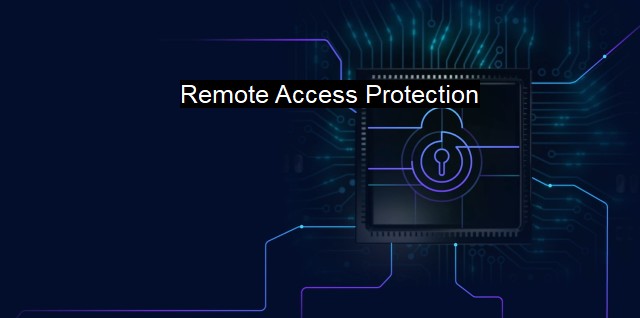What is Remote Access Protection?
Secure Your Organization with Remote Access Protection: Mitigating Security Risks for Remote Computing
Remote access is an essential aspect of modern computing. It allows users to access critical information from anywhere in the world, provided that an internet connection is available. remote access presents significant risks to cybersecurity. Allowing people to access sensitive information from remote locations may provide attackers with the opportunity to gain unauthorized access to data from outside the organization. In response to this threat, most cybersecurity professionals recommend using remote access protection protocols.Remote access protection describes measures that organizations implement to safeguard their IT infrastructure against unauthorized access. It seeks to mitigate the risks generated by remote computing by ensuring that users accessing sensitive information should be authorized before allowing them entry to the system. Remote access protection typically employs authentication and encryption protocols to ensure that external attacks or hacker attempts are not downloaded files lost from the network system. In other words, remote access protection creates a secure line between the internet and your network, making it difficult—or impossible—for attackers to access sensitive information without proper authorization.
One key aspect of remote access protection is establishing a secure connection between the accessing device—usually a computer or mobile device— and the organizational network. IT solutions like virtual private networks (VPNs) are some of the most widely used techniques. A VPN is a software-based tool that enables users to connect to the business environment through secure, encrypted tunnels over the Internet. VPNs is a simple and cost-effective solution with regard to the security associates needed to support these workflows, enabling authorized end-users to remote in securely and work seamlessly both in the office and remotely.
Another strategy is establishing strong user identification and authentication protocols. This involves multi-factor authentication—the process of requiring users to confirm who they are by entering several pieces of unique information such as usernames, passwords, security tokens fingerprints, or PINs, along with verification to ensure there is no breach as remote verification often lead to confusion amongst an acceptable breach such as not been authorized to a particular server or infrastructure. The multi-layer verification approach safeguards the connection by ensuring that only authorized users gain access to the sensitive data and resources in the organization.
remote access protection requires continuous monitoring to mitigate cyber risks that go bad. Monitoring of remote sessions ensures that the login attempts to the network are indeed originating from a trustworthy source. It also assists in detecting suspicious usernames or devices attempting to log in to user accounts.
It worth noting that remote access protection is a vital component of antivirus suite components. Although antivirus software is designed primarily to detect malware on computers or networks, it incorporates features to mandate this protection. Malware threats are common among remote computing solutions, and there is risk of nefarious software getting into the system involuntarily transfer unwanted traffic to the hosts. Cybercriminals often resort to malware to take over device controls. Thus, incorporating malware protection features should bolster the inter-related protacts within cybersecurity with effective remote access guidelines.
remote access is incredibly risky and is a common path through which organizations' critical data get lost to unauthorized third party. Remote access protection protocols, therefore, become quite a requisite analytic many companies, enabling them to build and implement strict security measures necessary for businesses to combat the risks affiliated with remote computing. In support of securing electronic devices and in authentication, remote access promotes overall cyber-strength by requiring users continually verify lack of conflicted efforts. Incorporating relevant checks regarding antivirus components should be implemented as they pose serious ransom applications. Employing reliable IT protection services cater security mitigation towards continual growth, offering a comprehensive IT defense strategy befitting of larger cyber-hacking events from contemporary events and unauthorized access to vital information. These factors safeguard an organization's bottom line by mitigating any financial constraints associated with hacking scenarios.

Remote Access Protection FAQs
What is remote access protection?
Remote access protection is a cybersecurity measure that aims to secure remote access to a network, system or device. It involves implementing security measures to prevent unauthorized access, protect sensitive data and minimize the risk of cyber attacks.Why is remote access protection important?
Remote access protection is important because it helps prevent cybercriminals from gaining unauthorized access to sensitive data, systems or networks. Without proper protection, cybercriminals can exploit vulnerabilities to steal data, infect systems with malware, and cause harm to the organization.What are some common remote access protection measures?
Some common remote access protection measures include using strong passwords, two-factor authentication, firewalls, virtual private networks (VPNs), and endpoint security solutions such as antivirus software.}} {{How can I ensure my remote access protection is effective?}} <| | A | | | B | | | C | | | D | | | E | | | F | | | G | | | H | | | I | | | J | | | K | | | L | | | M | |
| | N | | | O | | | P | | | Q | | | R | | | S | | | T | | | U | | | V | | | W | | | X | | | Y | | | Z | |
| | 1 | | | 2 | | | 3 | | | 4 | | | 7 | | | 8 | | |||||||